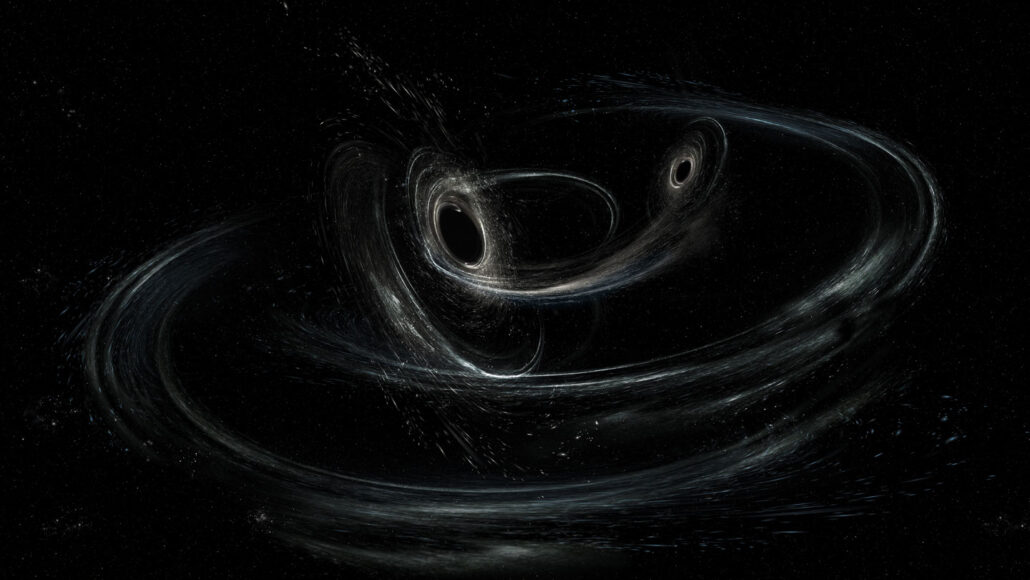Gravitational waves ‘kicked’ a newborn black hole across space
Two black holes merged, then sped off at some 5 million kilometers per hour

When two black holes spiral around each other before merging (illustrated), they kick up gravitational waves. Those waves can give the newly formed black hole a high-speed jolt.
LIGO, Caltech, MIT, Aurore Simonnet/Sonoma State
One black hole really knows how to kick back.
It was born when two others spiraled and smashed into each other. During its formation, this new black hole got a “kick” that flung it away from its birthplace. It zoomed off at about 5 million kilometers (3.1 million miles) per hour — give or take a few million.
That’s blazingly quick. Light is the fastest thing in the universe. And it’s only 200 times as fast as this black hole sped across space.
Researchers shared their new analyses in a paper being published in Physical Review Letters.
Cosmic kickback
Black holes are some of the most extreme objects in the cosmos. Each is so densely packed with matter that its gravity can keep even light from escaping. So, when two of these cosmic heavyweights collide, they pack a powerful punch. In fact, a black-hole collision can kick up ripples in the fabric of spacetime itself. Those ripples are called gravitational waves. And if those waves tend to spread out from a black hole smashup in one direction, they will knock the newborn black hole the other way.
This recoil is like a gun kicking back after shooting a bullet, explains Vijay Varma. He’s an astrophysicist at the Max Planck Institute for Gravitational Physics. That’s in Potsdam, Germany.
Varma was on the team that uncovered the black hole’s kickback. Observatories detected gravitational waves from merging black holes on January 29, 2020. These observatories — called LIGO and Virgo — are located in the United States and in Italy.
The detected waves revealed details about how the two black holes merged. As the black holes circled one another, the plane in which they orbited rotated. That tilt is called precession (Pre-SEH-shun). It’s similar to how a top wobbles as it spins. Such wobbly black holes are expected to get bigger kicks when they merge.
Varma and his colleagues wanted to know whether the newborn black hole really got such a boot. So, they delved deeper into the data.
The researchers compared their observations with predicted versions of black-hole mergers. They made those predictions using a computer model. Its simulations suggested the recoil was very large. That meant the newborn black hole was probably kicked to the cosmic curb.
An unclear fate
This black-hole kick could have happened in a couple of different environments. One is a dense group of stars and black holes. Such a celestial crowd is called a globular cluster. If the kicked black hole was born there, it likely escaped the cluster. There’s only about a 0.5 percent chance it stayed within its home, the team calculated.
But the black holes’ merger might also have happened in another type of dense environment. It’s called a nuclear star cluster. In that case, the kicked black hole had about an 8 percent chance of sticking around.
The black hole’s great escape could have big implications. Why? Scientists want to know if black holes that partner up and merge in crowded clusters could partner up again. Maybe black holes could go through multiple rounds of melding. If they do, that could help explain how some surprisingly bulky black holes came to be. But if merged black holes commonly rocket away from home, multiple mergers would be less likely.
“Kicks are very important in understanding how heavy stellar-mass black holes form,” Varma says. Stellar-mass black holes are the type that merged in the new study. They are born when dying stars explode and collapse. And they’re distinct from so-called supermassive black holes. Those much larger black holes rule the centers of galaxies.
Astronomers have seen hints of gravitational waves giving big kicks to such supermassive beasts before. But that evidence came in the form of light (not gravitational waves). “Gravitational waves, in a way, are cleaner and easier to interpret,” says Manuela Campanelli. This astrophysicist was not involved in the new study. She works at the Rochester Institute of Technology in New York.
LIGO and Virgo had offered some evidence of stellar-mass black holes getting small kicks. But the new study is the first to show such a black hole getting a large kick.
That big kick isn’t a surprise, Campanelli says. She and her colleagues had predicted such powerful kicks could happen. But she’s still pleased to see the new study. “It’s always exciting when someone can measure from observations what you predicted from calculations.”







